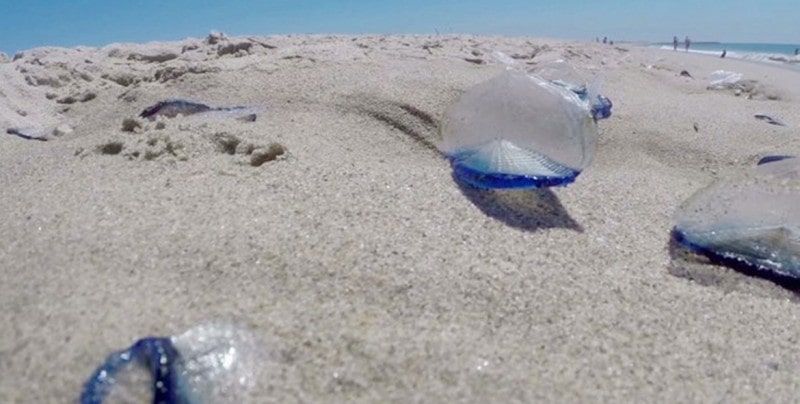Burners (quemadores) and the onset of rains in Mazatlan, Sinaloa
In Mazatlan, Sinaloa, the presence of burners (quemadores) on the beaches of the region is a sign that indicates the proximity of the rainy season.

The presence of burners ("quemadores") on the beaches of the region is a sign that indicates the proximity of the rainy season. The name of these organisms is due to the burning sensation that a person experiences when touched or brushed by the animal's tentacle. The burners or Physalias are common inhabitants of warm surface ocean waters and arrive on the region's beaches carried by winds and ocean currents from the south.
The beginning of the rainy season in Sinaloa is connected with the arrival of these current and wind systems that transport water and warmer and very humid air, which when ascending in the atmosphere cools and condenses. Winds from the south, third quadrant, are present in the region from May to October, and winds from the north, fourth quadrant, dominate from November to April. These wind systems and the presence of the rainy season are related to the migration of the regional low pressure system over western Mexico.
Winds blow from the north when the low pressure cell is located to the east of the Gulf of California, and winds blow from the south when this cell migrates towards the northwest due to the warming of the continental region, especially the head of the Gulf and surrounding areas; when this happens, the humid air currents from the Pacific Ocean, following the barometric slope, penetrate towards the interior of the Gulf and inland, where they cool as they ascend, producing condensation. According to the mechanism that produces the ascent of the wind, the following types of precipitation originate in the region during the summer:
Precipitation by convection
Results from the cooling of the air by expansion as it rises in the atmosphere, adiabatic cooling, due to the heating of the surface on which it rests. This convective ascent results in cumulus and cumulonimbus clouds that can extend several kilometers in height; the precipitation they produce can be abundant. The ascent of the air by convection takes place in the hot season of the year and in the hottest hours of the day. Convective rains do not cover large areas because cumulonimbus clouds only cover relatively small surfaces; due to the rapid ascent of the air, they also precipitate their moisture quickly, producing short-lived downpours.
Orographic precipitation
The air is forced to rise when it penetrates inland over the Sierra Madre Occidental, cools adiabatically and produces precipitation.
Cyclonic rains
In the Pacific Ocean, between 15°N and 20°N, there are multiple cyclonic disturbances during the months of June to November that generally follow parallel to the coast, but sometimes penetrate the territory. These disturbances bring heavy rains that cause strong floods in rivers and their tributaries.
More about the burners or quemadores
In the sea they are distinguishable as small floating bubbles of translucent blue color, however the most useful indicator to know that there are abundant burners in the water is when numerous dead organisms are found on the sand, which can be recognized by their transparent floats and thin bluish tentacles that accumulate on the shore of the beach.
When a person is touched or brushed by the tentacle of a burner, the burner's batteries trigger a series of cnidoblasts, poisonous defensive cells, whose venom is a neurotoxic protein that acts to paralyze most small animals. In humans the reactions are different, varying in each individual.
In some people they may be mild and in others severe, although this also depends on the species of Physalia, the amount of toxin administered, the size of the affected area and the sensitivity of the person, as some may present strong allergic reactions. Fortunately, the species common to the Sinaloan coasts, Physalia utriculus, generally produces only mild lesions.
Recommendations
The following are some recommendations for treating the "burns" produced by these animals:
Locate the affected area and carefully observe if it presents fragments of tentacles attached, if it is the case, remove the tentacle fragments with hands covered with handkerchief, towel or gloves. Wash the affected area with clean water and avoid rubbing with hot sand, since rubbing increases the damaged area and the lesion worsens due to the abrasive effect of the sand. Even if pain or itching predominates, do not scratch, because then the lesion tends to spread.
Apply ice or cold water compresses to the affected area for 10 to 20 minutes. It is recommended to cover the ice with a damp cloth. If necessary, continue to apply ice for a longer period of time.
If with the application of ice the pain does not diminish or other symptoms appear, go to the medical services, where they will probably apply anesthetics or cortisone ointments to stop the pain or allergic reaction.
Source: Noroeste




